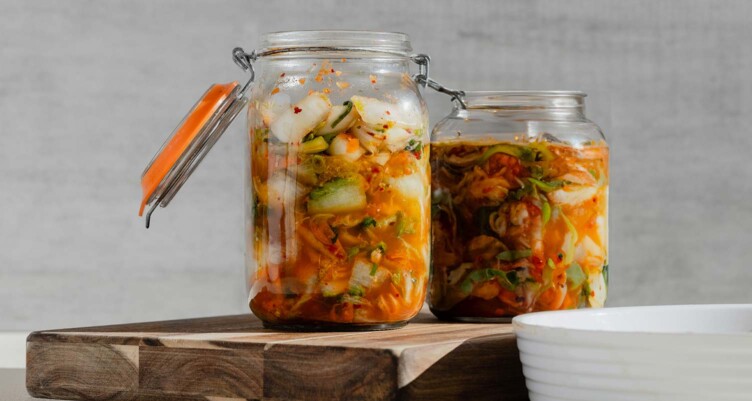Easy Kimchi Recipe

Ready to take your taste buds on a journey they’ve never experienced before? The first time you take a bite of this easy kimchi recipe, you will experience a whirlwind of flavors that can only be achieved from the magic of fermentation. Spicy, tangy and slightly sour, this popular Korean side dish will surely satisfy your craving for something crunchy while also providing your body with vitamins, micronutrients and probiotic support.
Fermented foods like kimchi and sauerkraut contain live microbes that boost your gut diversity and may help with better digestion. And while it might seem intimidating to make this Asian-inspired side at home, it’s actually quite easy.
How exactly does the kimchi making process work? Prep time starts with fermenting bite-sized pieces of cabbage leaves in a salty brine to achieve ultimate tenderness.
Then it’s time to get your hands a little dirty.
Once you add red pepper flakes, fish sauce, garlic, ginger, carrots and green onions to the cabbage (plus a scoop of Bulletproof Unflavored Collagen Peptides), you’ll need to give the mixture a thorough massage. You can also use daikon radish, celery, cucumber or other veggies laying around your fridge to create homemade kimchi.
Mason jars are your best bet for unlocking the full potential of this delicious side dish. After you’ve given the kimchi enough time to ferment (it gets more sour the longer it sits out), you can use it as a condiment on everything from tacos to fried rice for the ultimate umami kick. Just remember to refrigerate it afterward so your hard work doesn’t go to waste!
Easy Kimchi Recipe
https://www.bulletproof.com/recipes/easy-kimchi-recipe/
Ingredients
- 1 large napa cabbage (or Chinese cabbage)
- 1 carrot (grated)
- 3 scallions (thinly sliced)
- 1 inch fresh ginger (grated)
- 2 garlic cloves (crushed)
- 1 tsp cayenne pepper
- 1-2 tbsp chili flakes (or 20-50g of Korean chili powder, depending on your spice tolerance)
- 1-2 tbsp fish sauce
- 1 liter filtered water
- 3 tbsp sea salt
- 1 scoop Bulletproof Unflavored Collagen Peptides
- 1-liter glass jar with a rubber seal
Instructions
- Sterilize: Wash your hands well prior to touching the ingredients each time. Wash the chopping board, knife, bowl and glass jar in hot water and allow it to air dry.
- Rinse the vegetables and get rid of any dirt that may be on them.
- Make the brine by dissolving 3 tablespoons of salt in the filtered water.
- Cut the cabbage into large, bite-sized pieces and put aside two of the large outer leaves.
- Place the cabbage in a large bowl, pour over the brine and use a ceramic plate to keep the cabbage submerged for 1 hour. (Salting the cabbage makes it more tender while preserving its crunch. The salt also draws out some of the water by simple osmosis.)
- After the cabbage has soaked in the brine, pour it into a sieve or colander and quickly rinse the cabbage in filtered water (don’t thoroughly wash it).
- Add it back into the large bowl and add the carrots, ginger, garlic, fish sauce, scallions, chili flakes or Korean chili powder (to taste), cayenne pepper and mix well.
- Massage and bruise the cabbage mixture with your hands for approximately 5 minutes to help release the juices from the cabbage.
- Pour the kimchi mixture into the glass jar and pack it down well. Add all of the juices from the mixing bowl and leave a 2-inch gap from the top of the jar for any expansion.
- Roll up the two large outer leaves and place on top to keep the veggies submerged under the liquid. If you need a little more liquid, add a splash of filtered water and close the lid.
- Sit the jar out of direct sunlight for at least 3 days in warm climates and about 5-7 days in colder climates. The “finish point” depends on your taste. The longer you let the kimchi ferment, the sourer it will become. You can taste it each day when you check on it, and transfer it to the fridge when it tastes to your liking. Refrigeration will pause the fermentation process, where it will stay fresh for a minimum of three months.
Nutritional Information
- Calories: 15
- Fat: 1 g
- Protein: 1 g
- Fiber: 1 g
- Sugar: 1 g
- Carbohydrates: 3 g
- Net Carbs: 2 g
- Sodium: 1260 mg
Subscribe to our Recipe Lab newsletter for delicious recipes delivered to your inbox weekly!



